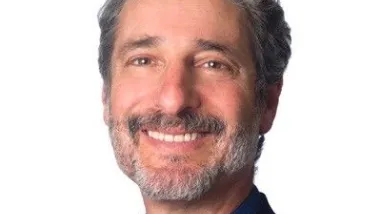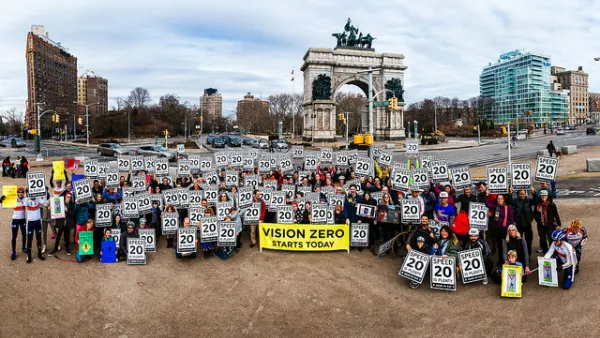Many jurisdictions have vehicle miles traveled (VMT) reduction targets, intended to reduce congestion and pollution. They can also provide large but often overlooked traffic safety benefits.

Many jurisdictions are officially committed to Vision Zero, an ambitious goal to eliminate all traffic deaths and severe injuries. Although some cities are making progress, most jurisdictions are failing. U.S. traffic death rates declined during the last half of the the 20th century, reaching a low of 32,479 in 2014, but subsequently increased, averaging about 37,000 annual deaths during each of the last three years. New strategies are needed to achieve ambitious safety goals.
Several new strategies exist, and are overall very cost effective, considering their total benefits, but are generally overlooked in conventional traffic safety planning. Conventional traffic safety programs tend to assume that motor vehicle travel is overall safe, and so favor targeted strategies that reduce higher-risk driving, such as graduated licenses, senior driver tests, and anti-impaired driving campaigns. However, such programs generally fail because it is not feasible to reduce high-risk driving alone. It is infeasible for most teenagers, seniors and drinkers to significantly reduce their driving in sprawled, automobile-dependent areas that lack non-auto travel options. Every time we tell somebody to reduce their high-risk driving, we have an obligation to create more accessible and multi-modal communities so they have viable alternatives.
Traffic Deaths Versus Vehicle Travel for OECD Countries

An abundance of research, described in the World Resources Institute report, "Sustainable & Safe: A Vision and Guidance for Zero Road Deaths," and in my report, "A New Traffic Safety Paradigm," indicates that, all else being equal, increases in motor vehicle travel increase crashes, and vehicle travel reductions increase safety. In other words, the new traffic safety paradigm recognizes exposure, the amount that people drive, as a risk factor. Since about 70% of casualty crashes involve multiple vehicles, so vehicle travel reductions provide proportionately large crash reductions. For example, if you reduce your mileage by 10%, your chance of being in a crash declines by 10%, but there is also a reduction in risk to other road users, since your vehicle is no longer vulnerable to other drivers' errors.
This means that we can increase safety by either reducing per-mile casualty rates through road and vehicle design improvement, and policies that reduce high-risk driving, and by reducing total vehicle travel which reduces total risk exposure. The old safety paradigm only considers the first approach. the new paradigm recognizes both approaches. The table below compares the old and new traffic safety paradigms.
Comparing the Old and New Traffic Safety Paradigms
Factor |
Old |
New |
|
Goal |
Make vehicle travel safer. |
Make transportation systems safer. |
|
Risk measurement |
Direct user risks, measured by distance (e.g., occupant deaths per 100,000 million vehicle-miles). |
Total risks, including risks to other road users, measured by distance and per capita |
|
Solutions considered |
Roadway and vehicle design improvements Graduated licenses Senior driver testing Seatbelt and helmet requirements Anti-impaired and distracted driving campaigns |
Walking, bicycling and public transit improvements Road, parking, fuel and insurance pricing reforms More connected and complete roadways Smart Growth development policies Transportation demand management programs |
|
Analysis scope |
Program costs and traffic safety benefits |
All economic, social and environmental impacts |
The new paradigm expands the range of potential traffic safety strategies to include a variety of
Transportation Demand Management (TDM) strategies including improvements to non-auto modes, transportation pricing reforms, commute trip reduction and school transport management programs, and Smart Growth development policies. The table below indicates old and new traffic safety strategies. These approaches can complement each other. For example graduated licenses, senior driver testing and anti-impaired driving campaigns are more effective if youths, seniors, and drinkers have better alternatives to driving.
Old and New Traffic Safety Strategies
|
Old Safety Programs |
New Paradigm Safety Strategies |
|
|
The new paradigm significantly expands the scope of traffic safety programs to include VMT reduction strategies.
The old paradigm emphasize that most crashes result from special risk factors, such as youth, senior, impaired or distracted driving, and so favor safety strategies that target just these risks. From this perspective it seems inefficient and unfair to reduce all vehicle travel for safety sake, since that "punishes" responsible drivers for errors made by an irresponsible minority. However, even a perfect driver who never errors increases safety by reducing mileage and therefore their chance of being the victim of other drivers’ mistakes, and most drivers make small errors that can contribute to a crash, such as driving a little faster than optimal for safety. Since most casualty crashes involve multiple vehicles, travel reductions tend to provide proportionately larger crash reductions, particularly in urban areas. As a result, mileage reductions by lower-risk drivers increases traffic safety.
It is also wrong to assume that vehicle travel reductions necessarily “punish” drivers: many vehicle travel reduction strategies benefit all road users by improving travel options and providing positive incentives to use alternatives to driving, which directly benefits the travellers who shift mode, and benefits motorists by reducing traffic and parking congestion, and increasing their safety. Considering all impacts new paradigm safety strategies are often very cost effective.
There is a positive message here. Communities can significantly increase safety and achieve many other planning objectives (reduced traffic and parking congestion, improved public health, infrastructure savings, increased affordability, more independent mobility for non-drivers, energy conservation, and emission reductions) by implementing more multi-modal planning, more efficient transportation pricing, targeted transport demand management programs, and Smart Growth development policies. Although few people want to forego driving altogether, consumer surveys indicate that many want to live in more walkable neighborhoods where they can drive less and rely more on walking, bicycling, and public transit.
However, we face a challenge. Most traffic safety experts are stuck in the old paradigm. Of 19 major traffic safety programs and guidebooks reviewed in my report (Table 6) only six even mentioned vehicle travel reduction strategies, and many of those are limited, for example, only supporting special transit service improvements to reduce drunk driving rather than system-wide improvements and transit-oriented development to create neighborhoods where residents own fewer cars, drive less, and are safer and healthier as a result. Transportation professionals should support systematic reforms rather than just targeted strategies.
What do we want? Safer transportation systems! When do we want them? Now!
For More Information
Hamed Ahangari, Carol Atkinson-Palombo and Norman Garrick (2017), “Automobile Dependency as a Barrier to Vision Zero: Evidence from the States in the USA,” Accident Analysis and Prevention, Vol. 107, pp. 77-85.
Michelle DeRobertis, et al. (2014), “Changing the Paradigm of Traffic Impact Studies: How Typical Traffic Studies Inhibit Sustainable Transportation,” ITE Journal (www.ite.org), May, pp. 30-35.
Eric Dumbaugh and Robert Rae (2009), “Safe Urban Form: Revisiting the Relationship Between Community Design and Traffic Safety,” Journal of the American Planning Association, Vol. 75, No. 3, Summer (DOI: 10.1080/01944360902950349).
Reid Ewing, Shima Hamidi and James Grace (2016), “Urban Sprawl as a Risk Factor in Motor Vehicle Crashes,” Urban Studies, Vol. 53/2, pp. 247-266 (doi.org/10.1177/0042098014562331).
David C. Grabowski and Michael A. Morrisey (2006), “Do Higher Gasoline Taxes Save Lives?” Economics Letters, Vol. 90, pp. 51–55.
Shirlee Lichtman-Sadot (2019), “Can Public Transportation Reduce Accidents? Evidence from the Introduction of Late-Night Buses in Israeli Cities, Regional Science and Urban Economics, Vol. 74, pp. 99-117 (https://doi.org/10.1016/j.regsciurbeco.2018.11.009).
Todd Litman (2012), “Pricing for Traffic Safety: How Efficient Transport Pricing Can Reduce Roadway Crash Risks,” Transportation Research Record 2318, pp. 16-22 (www.trb.org).
Todd Litman (2019), Are Vehicle Travel Reduction Targets Justified? Victoria Transport Policy Institute (www.vtpi.org).
Wesley E. Marshall and Nicholas N. Ferenchak (2019), “Why Cities with High Bicycling Rates are Safer for All Road Users,” Journal of Transport & Health, Volume 13.
Jason Thompson, et al. (2020), “A Global Analysis of Urban Design Types and Road Transport Injury: An Image Processing Study,” The Lancet.
Ben Welle, et al. (2018), Sustainable & Safe: A Vision and Guidance for Zero Road Deaths, World Resources Institute (www.wri.org) and Global Road Safety Facility (www.worldbank.org/grsf).
Jiho Yeo, Sungjin Park and Kitae Jang (2015), “Effects of Urban Sprawl and Vehicle Miles Traveled on Traffic Fatalities,” Accident Analysis and Prevention, Vol. 16, No. 4, pp. 397-403.

Planetizen Federal Action Tracker
A weekly monitor of how Trump’s orders and actions are impacting planners and planning in America.

Chicago’s Ghost Rails
Just beneath the surface of the modern city lie the remnants of its expansive early 20th-century streetcar system.

Amtrak Cutting Jobs, Funding to High-Speed Rail
The agency plans to cut 10 percent of its workforce and has confirmed it will not fund new high-speed rail projects.

Ohio Forces Data Centers to Prepay for Power
Utilities are calling on states to hold data center operators responsible for new energy demands to prevent leaving consumers on the hook for their bills.

MARTA CEO Steps Down Amid Citizenship Concerns
MARTA’s board announced Thursday that its chief, who is from Canada, is resigning due to questions about his immigration status.

Silicon Valley ‘Bike Superhighway’ Awarded $14M State Grant
A Caltrans grant brings the 10-mile Central Bikeway project connecting Santa Clara and East San Jose closer to fruition.
Urban Design for Planners 1: Software Tools
This six-course series explores essential urban design concepts using open source software and equips planners with the tools they need to participate fully in the urban design process.
Planning for Universal Design
Learn the tools for implementing Universal Design in planning regulations.
Caltrans
City of Fort Worth
Mpact (founded as Rail~Volution)
City of Camden Redevelopment Agency
City of Astoria
City of Portland
City of Laramie






























